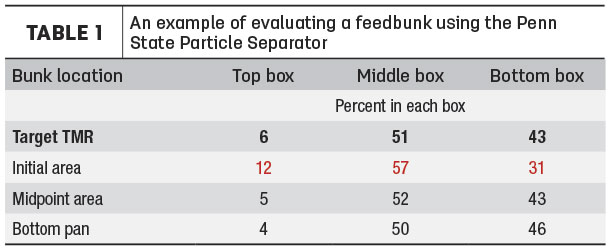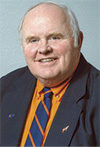Ann sent an email asking how to evaluate Bob, her TMR feeder (individual that mixes and delivers rations to dairy cattle on her farm). She is concerned with variation in daily milk yield in her herd. Her question is, what tools or areas could she review to evaluate Bob’s performance in delivering TMR to the herd? Ann does not plan to let Bob know she is monitoring his work until she has finished her evaluation.
Non-feed areas to explore
My first recommendation is to visit with Bob discussing Ann’s concerns and why she suspects the variation in milk yield is related to Bob’s ration mixing and delivery. Bob may have ideas and problems he is facing. The following non-feed areas and questions may be helpful.
- Is there a pattern to changes in milk yield per cow? For example, does it occur on weekends, only on Wednesday or randomly?
- How large are the swings in milk yield (over 2 pounds per cow, for example)?
- When are fresh cows added to the bulk tank and dry cows removed (for example, on Wednesday)? These changes will affect bulk milk levels.
- Are cows moved between groups routinely? If cow numbers are shifting between pens, milk yield will be impacted.
- What weather conditions could be influencing dry matter intake? Hot weather, high humidity, and rain and/or snow can reduce feed intake, shift dry matter content in the TMR, reduce palatability in the feedbunk, and adding wetter silage by weight will shift the nutrient content of the TMR due to higher moisture content of the silage. For example, adding 4,000 pounds of haylage with 40% dry matter results in 1,600 pounds of haylage dry matter, while adding 4,000 pounds of haylage containing 35% dry matter due to rain results in 1,400 pounds of haylage dry matter added to the TMR.
Evaluate TMR changes and risks
Three areas outlined below could lead to variable feed intake and changes in milk yield.
Focus on the TMR mixer
- Is the mixer showing signs of wear that limits accurate and uniform mixing?
- How long does it take to complete the filling and mixing time of the each ingredient and total time? Does this time change from mix to mix and day to day? Are you timing this activity routinely?
- What is the order of adding feed ingredient to the TMR? Grain and dry hay are added first (allowing for processing the hay shorter if needed) followed by haylage, corn silage (easier to mix and has desirable particle size) and end with liquids (molasses, liquid blends and/or water).
Focus on feed ingredients
- Are forages at optimal particle size? No forage particles over 1 inch in length are present, leading to sorting.
- Is pre-processing of straw, hay, baleage or other long forages done to avoid weighing errors, provide a more consistent TMR due to forages not clinging together and reduce the risk of sorting. Hay can separate in the feed storage area after processing with pockets of leaves and stems, leading to variation.
- Are silage dry matter and TMR dry matter levels monitored on a weekly basis or after a weather incidence such as rain? Check dry matter content using a Koster tester, food dehydrator or other drying system that can be used on the farm.
- Are pre-mixtures used on the farm? One guideline is no feed ingredient is added to the TMR unless it’s contained in a 2-pound mix per cow. For example, a mineral mix fed at an 8-ounce feeding rate is mixed with a carrier feed (such as dry ground corn or a byproduct feed) to bring the added amount to 2 or more pounds. This strategy allows the TMR mixer to uniformly mix, avoid multiple weighing of smaller feed ingredients, and minimize overfeeding or underfeeding expensive ingredients. Pre-mixtures can done when the TMR unit is available on the farm. Be sure the feed particle sizes are similar to avoid separation after mixing.
- When is TMR dropped or fed to cows? Ideally, fresh TMR should be available when cows return from the milking parlor. Is fresh TMR provided at the same time of the day every day?
Focus on the feedbunk
- Is there evidence of feed sorting? When watching cows consume TMR after returning from the parlor, do they aggressively consume feed or push it around? Do you see feed pockets or holes in the TMR in your feedbunk?
- How often is feed pushed up each day? Do cows respond to the push-up activity by coming back to the feedbunk?
- Does the feed appear uniformly mixed? Fuzzy cottonseed or pelleted feed are marker feeds. Do these marker feeds appear uniformly in each handful of TMR?
- Does the TMR heat up in the feedbunk due to secondary fermentation?
- Does the TMR dry out due to wind and temperature changes?
- What level of weighback is occurring? Our guideline is 2% to 4% when milk prices are favorable.
- Are the weighback or feed refusals sorted what limits intake and changes the ration that is being consumed? Our guideline is plus or minus 5 percentage units using the Penn State Particle Separator from the original TMR delivered.

Useful tools to evaluate TMR
- A Penn State Particle Separator is a useful tool to “shake out” or sieve the TMR to determine if the mixer is uniformly mixing the TMR. Take samples from several areas along the feedbunk (initial, midpoint and at the end of delivering TMR) before cows have access to the TMR. One guideline is to compare these multiple shakeouts with a goal of plus or minus 5% of the average in each box. An example is illustrated in Table 1. In this example, more long particles were delivered at the initial discharge while the bottom box had lower levels of grain and concentrate. Diamond V Mills conducts TMR audits shaking 10 or more TMR samples for the same mix and conducts a statistical evaluation of variation.
- Calculate feed efficiency of each pen if you have accurate milk yield by pen and pounds of TMR delivered to the pen. (An electronic weighing and monitoring system makes this easier.) Feed efficiency is pounds of 3.5% fat-corrected milk by the pounds of dry matter consumed (weighback amounts should be subtracted). The correct number of cows in the pen is critical.
- Testing the TMR through a forage testing lab can be another approach. My suggestion is to test for dry matter, crude protein and neutral detergent fiber (NDF) using wet chemistry (major nutrients compared to mineral content to minimizing sampling risk). One concern is obtaining an accurate sample to be tested, realizing the tested sample in the lab is small.
Meeting with Bob
During your one-on-one meeting, how does Bob react to your concerns and data? I hope that Bob shares Ann’s concerns and will be willing to try to solve problems, risks or limitation in the feeding program. If Bob is committed to his phase of the dairy operation (feeding the herd), he may want to assist in collecting data, charting results and/or suggest changes. If Bob is not interested, shifting him to another position on the dairy farm is an alternative. You could discuss a financial incentive plan in feeding areas that he controls, such as accuracy in adding feed ingredients or uniform mixing of the TMR-based Penn State Particle Separator results. Finally, do you have a standard operating procedure (SOP) listing benchmarks and guidelines outlined above? Bob is critically important to your farm; be sure you have the “right” Bob as your feeder. ![]()

-
Michael Hutjens
- Professor of Animal Sciences Emeritus
- University of Illinois – Urbana
- Email Michael Hutjens






